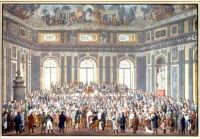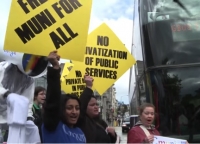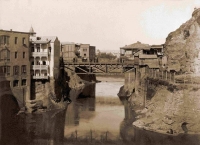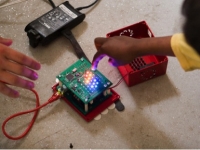Power and the Audiovisual
As part of the Global Urban Humanities Initiative Colloquium called Reading Cities, Sensing Cities we have asked students and visitors to write responses to each of the weekly guest lectures.
October 23, 2014
Urban Space, Spectacle, Memory and Music in Nineteenth-Century Vienna
Nicholas Mathew (Music)
Presentation available here.
Video of the conversation available here.
Mathew presented on the role of music and sound in the emergence of modern civic sensibilities in Napoleonic Vienna, and how printed music came to shape a new politics of urban pedestrianism.
by Brandon Harrell
On October 23, Professor Nicolas Mathew gave us a taste of the Congress of Vienna as it was post-Napoleonic War. He challenged his audience, our classroom, to focus on the words “spectator” and “audience” as he explained how the Congress would organize grand events in urban spaces to acknowledge the elite heads of state while also arousing the masses. The large spaces, once bustling the day before with activity, were converted into pavilion-like landscapes where all things regal were admired. Again, I thought to myself, dramaturgy. I am being compelled to view the city as a spectacle where everyday life is a performance, where the image of the city is mediated by a binary social relationship, where individual choices are made in the sphere of production and consumption. In this case, the state of Vienna was producing an image, organized with symphonic arrangements to be consumed by the masses. The music would blast, sonic boom after sonic boom, and the words (in German) would describe and glorify particular events, solidifying them in historical memory. These elite narratives were more aural fantasy than anything and, as the music boomed over the spectators they were not being shaken into obedience, but becoming aware of themselves as an audience en masse. The public became aware of its own presence. Individual privacy of expression is gone when one becomes usurped by the crowd. All is laid bare; what would be a passive, disorganized sound becomes an active clamor of the masses.
The urban experience is fragmented and dramatic, and as Mathew focused deeper on the music and grand public performances of Vienna, I could not help but ask, “Where does state-sponsored music and performance fit into our cities today? How do we produce sound and communal identity through performance theory?” Knowing that the U.S. government maintains power norms through the commodification of resources and space, I believe that sound and image cannot be separated from space. We often don’t think of the commodification of land and space as directly affecting our audiovisual opportunities and what those audiovisual opportunities can do for us but let’s ponder for a moment: as more and more land becomes privatized, there are fewer public spaces in which to perform, to act, to play, to be free, physically. The cars, planes, drones, and construction drown out the music, the rhythms, the voices, the stories; that car blasting Drake or Lil Wayne as it winds down Telegraph only passes by for a second. Then, the roars and bustle are quickly back at the forefront-–that is the norm. Billboards, fast-food signs, curb paint and road paint, streetlights and the entangled web of telephone poles and wires, all distract from our relationship with space, passively extracting opportunities for collective voice and expression.
Where and how can we reclaim space, reclaim our voice? All of my examples come not from those in power, but the oppressed. Performing participatory pedestrianism–from the gypsy, flamenco culture of Andalusia, Spain, to the Black, hip-hop culture of North America–-they all screamed, “Fight the power! Pa’lante siempre!” By existing in these spaces we reclaim them. That message juxtaposed against the monolithic drone of commerce and mainstream media kind of summarizes U.S. society today…
Here is some local inspiration… a response to the death of a young, Black boy named June.
Brandon Harrell is a graduate student in the Master of City Planning program at the UC Berkeley College of Environmental Design.
The Sound of Urban Spectacle
 As part of the Global Urban Humanities Initiative Colloquium called Reading Cities, Sensing Cities we have asked students and visitors to write responses to each of the weekly guest lectures. October 23, 2014 Urban Space, Spectacle, Memory and Music in Nineteenth-Century Vienna Nicholas Mathew (Music) Presentation available here. Video of the conversation available here. Mathew presented on the role of music and sound in the emergence of modern civic sensibilities in Napoleonic Vienna, and how printed music came to shape a new politics of urban pedestrianism. by Swetha Vijayakumar “The spectacle is not a collection of images; rather, it is…
As part of the Global Urban Humanities Initiative Colloquium called Reading Cities, Sensing Cities we have asked students and visitors to write responses to each of the weekly guest lectures. October 23, 2014 Urban Space, Spectacle, Memory and Music in Nineteenth-Century Vienna Nicholas Mathew (Music) Presentation available here. Video of the conversation available here. Mathew presented on the role of music and sound in the emergence of modern civic sensibilities in Napoleonic Vienna, and how printed music came to shape a new politics of urban pedestrianism. by Swetha Vijayakumar “The spectacle is not a collection of images; rather, it is…
An Engaged Populace Through Music
 As part of the Global Urban Humanities Initiative Colloquium called Reading Cities, Sensing Cities we have asked students and visitors to write responses to each of the weekly guest lectures. October 23, 2014 Urban Space, Spectacle, Memory and Music in Nineteenth-Century Vienna Nicholas Mathew (Music) Presentation available here. Video of the conversation available here. Mathew presented on the role of music and sound in the emergence of modern civic sensibilities in Napoleonic Vienna, and how printed music came to shape a new politics of urban pedestrianism. by Matthew Goodman This week’s lecture provided an interesting glimpse into how music shaped…
As part of the Global Urban Humanities Initiative Colloquium called Reading Cities, Sensing Cities we have asked students and visitors to write responses to each of the weekly guest lectures. October 23, 2014 Urban Space, Spectacle, Memory and Music in Nineteenth-Century Vienna Nicholas Mathew (Music) Presentation available here. Video of the conversation available here. Mathew presented on the role of music and sound in the emergence of modern civic sensibilities in Napoleonic Vienna, and how printed music came to shape a new politics of urban pedestrianism. by Matthew Goodman This week’s lecture provided an interesting glimpse into how music shaped…
Redirecting the Relationship Between Tech and Innovation
 As part of the Global Urban Humanities Initiative Colloquium called Reading Cities, Sensing Cities we have asked students and visitors to write responses to each of the weekly guest lectures. October 16, 2014 Creative Class Civil Wars: Displacement and the Arts in the Bay Area Shannon Steen (Theater, Dance, and Performance Studies) Presentation available here. Video of the conversation available here. Steen presented research from her project “Creative Class Civil Wars,” which explores the ways our concepts of creativity are shifting to exclude those in the arts. by Robyn Perry "The notion that diversity in an early team is important…
As part of the Global Urban Humanities Initiative Colloquium called Reading Cities, Sensing Cities we have asked students and visitors to write responses to each of the weekly guest lectures. October 16, 2014 Creative Class Civil Wars: Displacement and the Arts in the Bay Area Shannon Steen (Theater, Dance, and Performance Studies) Presentation available here. Video of the conversation available here. Steen presented research from her project “Creative Class Civil Wars,” which explores the ways our concepts of creativity are shifting to exclude those in the arts. by Robyn Perry "The notion that diversity in an early team is important…
From Bricks to Bus Stops: Protesting San Francisco’s Second Tech Boom
 As part of the Global Urban Humanities Initiative Colloquium called Reading Cities, Sensing Cities we have asked students and visitors to write responses to each of the weekly guest lectures. October 16, 2014 Creative Class Civil Wars: Displacement and the Arts in the Bay Area Shannon Steen (Theater, Dance, and Performance Studies) Presentation available here. Video of the conversation available here. Steen presented research from her project “Creative Class Civil Wars,” which explores the ways our concepts of creativity are shifting to exclude those in the arts. by Will Payne Shannon Steen’s presentation about the shifting role the term “creative”…
As part of the Global Urban Humanities Initiative Colloquium called Reading Cities, Sensing Cities we have asked students and visitors to write responses to each of the weekly guest lectures. October 16, 2014 Creative Class Civil Wars: Displacement and the Arts in the Bay Area Shannon Steen (Theater, Dance, and Performance Studies) Presentation available here. Video of the conversation available here. Steen presented research from her project “Creative Class Civil Wars,” which explores the ways our concepts of creativity are shifting to exclude those in the arts. by Will Payne Shannon Steen’s presentation about the shifting role the term “creative”…
Crossroads Modernity: The Case of Tbilisi
 As part of the Global Urban Humanities Initiative Colloquium called Reading Cities, Sensing Cities we have asked students and visitors to write responses to each of the weekly guest lectures. October 9, 2014 Uneven Modernity and the “Peripheral” City: Between Ethnography, History and Literature in Tbilisi Harsha Ram (Slavic Languages and Literature; Comparative Literature) Video of the conversation available here. Ram discussed the literary culture of Tbilisi as it relates to modernism and the unique history of Georgia. by Elisa Russian Tbilisi, the current capital of Georgia, was founded in the 5th century on one of the main trade and…
As part of the Global Urban Humanities Initiative Colloquium called Reading Cities, Sensing Cities we have asked students and visitors to write responses to each of the weekly guest lectures. October 9, 2014 Uneven Modernity and the “Peripheral” City: Between Ethnography, History and Literature in Tbilisi Harsha Ram (Slavic Languages and Literature; Comparative Literature) Video of the conversation available here. Ram discussed the literary culture of Tbilisi as it relates to modernism and the unique history of Georgia. by Elisa Russian Tbilisi, the current capital of Georgia, was founded in the 5th century on one of the main trade and…
Urban Ap(ART)heid: Who and Who Defines Citizenship?
 As part of the Global Urban Humanities Initiative Colloquium called Reading Cities, Sensing Cities we have asked students and visitors to write responses to each of the weekly guest lectures. October 2, 2014 Experiments in Online and Print Journals on Cities: Urban Pilgrimage and pARTicipatory Urbanisms Padma Maitland (Architecture and South and Southeast Asian Studies), Lawrence Yang (East Asian Languages and Cultures), Karin Shankar (Performance Studies), and Kirsten Larson (City and Regional Planning and Architecture) Presentations available here. Video of the conversation available here. Padma, Lawrence, Karin, and Kirsten shared reflections on their research and the process of curating their…
As part of the Global Urban Humanities Initiative Colloquium called Reading Cities, Sensing Cities we have asked students and visitors to write responses to each of the weekly guest lectures. October 2, 2014 Experiments in Online and Print Journals on Cities: Urban Pilgrimage and pARTicipatory Urbanisms Padma Maitland (Architecture and South and Southeast Asian Studies), Lawrence Yang (East Asian Languages and Cultures), Karin Shankar (Performance Studies), and Kirsten Larson (City and Regional Planning and Architecture) Presentations available here. Video of the conversation available here. Padma, Lawrence, Karin, and Kirsten shared reflections on their research and the process of curating their…
Publications of Access and Agency
 As part of the Global Urban Humanities Initiative Colloquium called Reading Cities, Sensing Cities we have asked students and visitors to write responses to each of the weekly guest lectures. October 2, 2014 Experiments in Online and Print Journals on Cities: Urban Pilgrimage and pARTicipatory Urbanisms Padma Maitland (Architecture and South and Southeast Asian Studies), Lawrence Yang (East Asian Languages and Cultures), Karin Shankar (Performance Studies), and Kirsten Larson (City and Regional Planning and Architecture) Presentations available here. Video of the conversation available here. Padma, Lawrence, Karin, and Kirsten shared reflections on their research and the process of curating their…
As part of the Global Urban Humanities Initiative Colloquium called Reading Cities, Sensing Cities we have asked students and visitors to write responses to each of the weekly guest lectures. October 2, 2014 Experiments in Online and Print Journals on Cities: Urban Pilgrimage and pARTicipatory Urbanisms Padma Maitland (Architecture and South and Southeast Asian Studies), Lawrence Yang (East Asian Languages and Cultures), Karin Shankar (Performance Studies), and Kirsten Larson (City and Regional Planning and Architecture) Presentations available here. Video of the conversation available here. Padma, Lawrence, Karin, and Kirsten shared reflections on their research and the process of curating their…
Black Cloud: A Case Study on Data and Empowerment
 As part of the Global Urban Humanities Initiative Colloquium called Reading Cities, Sensing Cities we have asked students and visitors to write responses to each of the weekly guest lectures. September 25, 2014 Sensing San Leandro: Capturing Cityscapes Through Sensors Greg Niemeyer (Art Practice) and Ron Rael (Architecture and Art Practice) Presentation available here. Video of the conversation available here. Niemeyer and Rael discussed how using sensors to collect data allow “reality-based” decisions about places to be made, using projects that they and their students have undertaken in San Leandro as examples. by Will Payne Professors Niemeyer and Rael are…
As part of the Global Urban Humanities Initiative Colloquium called Reading Cities, Sensing Cities we have asked students and visitors to write responses to each of the weekly guest lectures. September 25, 2014 Sensing San Leandro: Capturing Cityscapes Through Sensors Greg Niemeyer (Art Practice) and Ron Rael (Architecture and Art Practice) Presentation available here. Video of the conversation available here. Niemeyer and Rael discussed how using sensors to collect data allow “reality-based” decisions about places to be made, using projects that they and their students have undertaken in San Leandro as examples. by Will Payne Professors Niemeyer and Rael are…
An Example of Data Reshaping Daily Life in China
 As part of the Global Urban Humanities Initiative Colloquium called Reading Cities, Sensing Cities we have asked students and visitors to write responses to each of the weekly guest lectures. September 25, 2014 Sensing San Leandro: Capturing Cityscapes Through Sensors Greg Niemeyer (Art Practice) and Ron Rael (Architecture and Art Practice) Presentation available here. Video of the conversation available here. Niemeyer and Rael discussed how using sensors to collect data allow “reality-based” decisions about places to be made, using projects that they and their students have undertaken in San Leandro as examples. by Mengyuan Jin At a time of increasing data–orientation,…
As part of the Global Urban Humanities Initiative Colloquium called Reading Cities, Sensing Cities we have asked students and visitors to write responses to each of the weekly guest lectures. September 25, 2014 Sensing San Leandro: Capturing Cityscapes Through Sensors Greg Niemeyer (Art Practice) and Ron Rael (Architecture and Art Practice) Presentation available here. Video of the conversation available here. Niemeyer and Rael discussed how using sensors to collect data allow “reality-based” decisions about places to be made, using projects that they and their students have undertaken in San Leandro as examples. by Mengyuan Jin At a time of increasing data–orientation,…




